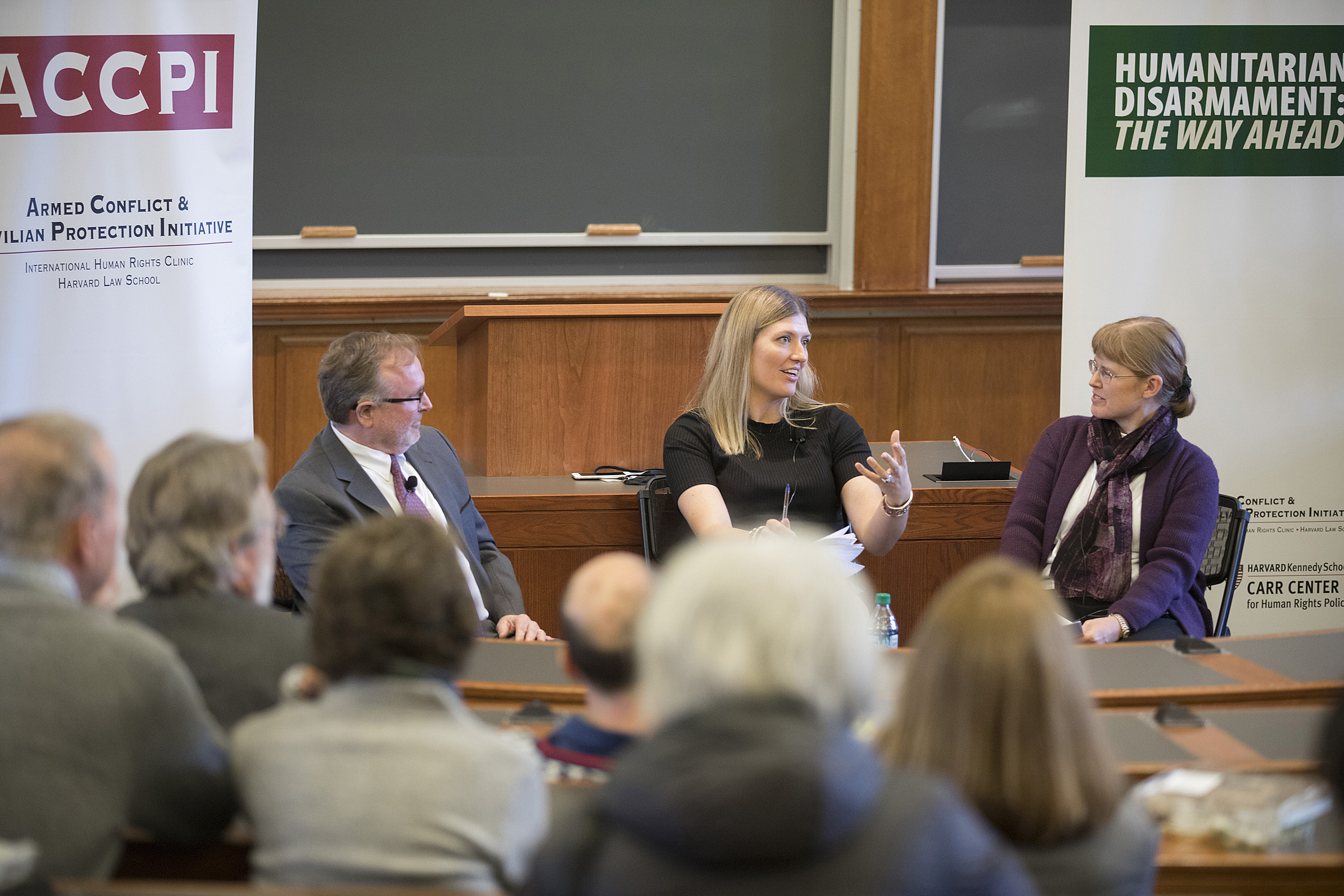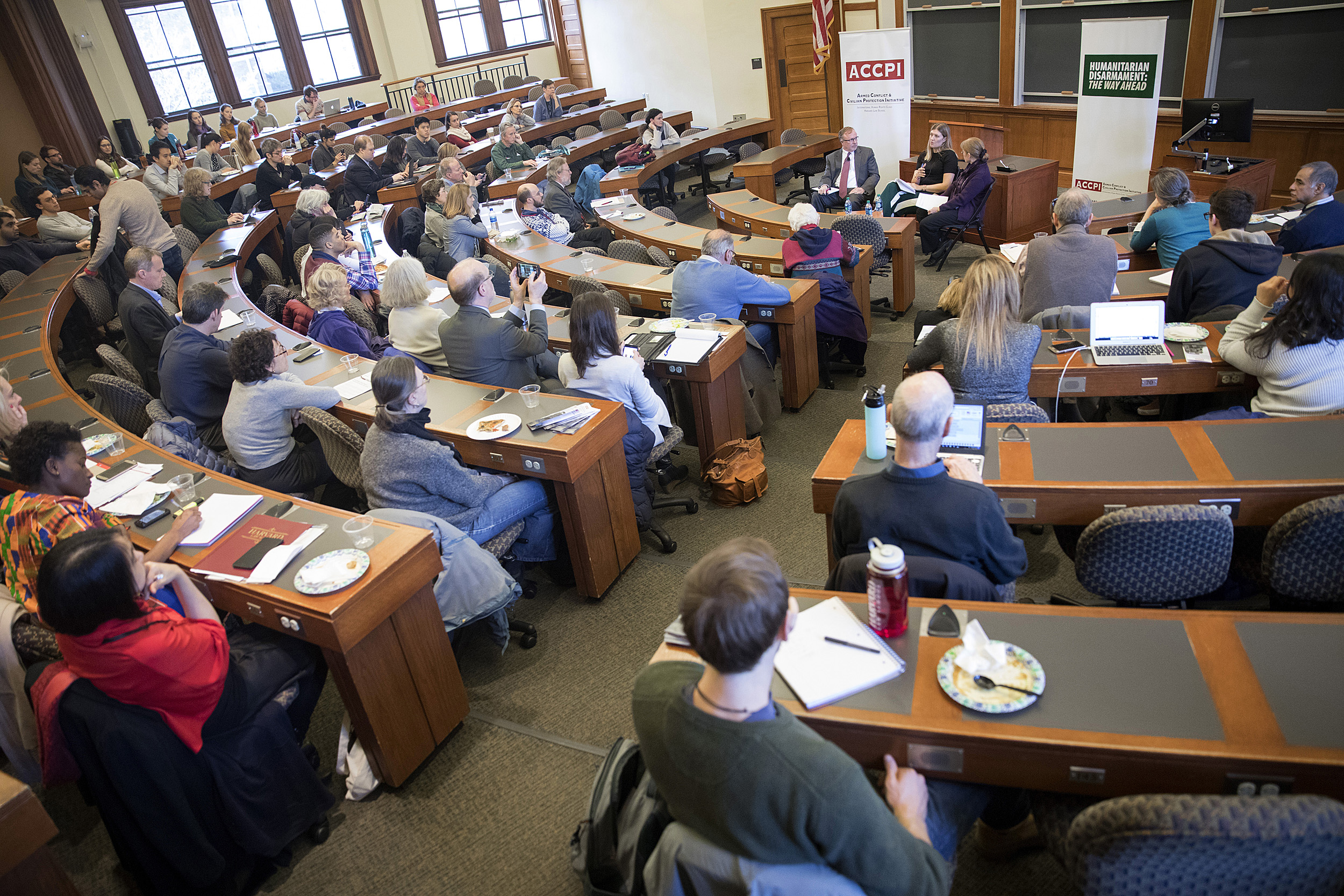
During “From Landmines to Nuclear Weapons,” a panel featuring Steve Goose (from left) and Beatrice Fihn and moderated by Bonnie Docherty of the Law School addressed the origins and evolution of humanitarian disarmament while reflecting on their roles negotiating treaties that ban landmines, cluster munitions, and nuclear weapons.
Kris Snibbe/Harvard Staff Photographer
One win against weapons could fuel another
Successful campaign banning landmines could provide blueprint against nuclear arms, panel says
When the movement began in 1992, the International Campaign to Ban Landmines was considered quixotic, its proponents unrealistically idealistic, its efforts doomed to fail. Twenty-five years and one Nobel Peace Prize later, more than 180 countries have signed its 1997 treaty, agreeing not only to avoid using the weapons but to help remove them from areas where they have been abandoned and remain a danger to life, limbs, and livelihoods.
More like this
Nuclear weapons, now a reality of our modern world, could go the same way, say the activists behind the International Campaign to Abolish Nuclear Weapons. Indeed, humanitarian rights activists say, they must. On Monday at Harvard Law School’s Austin Hall, the anti-nuclear campaign’s executive director, Beatrice Fihn, joined Steve Goose, co-founder of the landmines-ban group and executive director of Human Rights Watch’s arms division, to discuss the origin and evolution of the mine campaign, and how the tactics of the first can be applied to the next.
“Everybody said it was impossible to do,” said Goose, looking back at the long road to the 1997 landmine treaty. “After we finally did it, people said, ‘Oh, that wasn’t that hard. It was a one-off. Circumstances allowed that to happen.’” They also, he reported, said its success could not be replicated.
Monday’s discussion was designed to prove that false. Indeed, this first public event of Humanitarian Disarmament: The Way Ahead (moderated by Bonnie Docherty, associate director of Armed Conflict and Civilian Protection at Harvard Law School’s International Human Rights Clinic) started off by outlining the similarities — and the successes — of other recent campaigns.
“Ten years later, we had a treaty banning cluster munitions,” noted Goose. “We used the same approach, a coalition of progressive governments and the ICRC [International Committee of the Red Cross] and various U.N. agencies. By focusing on a catchphrase, ‘Let’s ban cluster munitions that cause unacceptable harm to civilians,’ using much the same approach and methodology, we got a ban in 2008.”
That methodology began with a grassroots approach. “First and foremost, you see civil society driving the process,” Goose said. In the case of landmines, he noted, society said, “No, we can’t have more than 20,000 people killed or injured by these each year.”

A packed Austin Hall welcomed Goose and Fihn.
Kris Snibbe/Harvard Staff Photographer
In the next step, activist citizens sought out allies, including progressive governments and international organizations (UNICEF was deeply involved in the landmine cause). Goose described creating a partnership between non-governmental organizations (NGOs) and a core group of governments that “spoke every day, conspiring to make the ban on landmines come about.”
The nuclear ban group is making similar moves, said Fihn. Although there is no lack of NGOs working for nuclear disarmament, she said, the movement tends to be spread out, with much of the effort working to coordinate into “one big push.”
The International Campaign to Abolish Nuclear Weapons succeeded in getting a treaty banning nuclear weapons moving last July, and 122 states adopted it in the United Nations. The group won the 2017 Nobel Peace Prize for its work.
Thus far, some nations, including the U.S., Russia, and China, have refused to sign onto the ban. However, she said, her group is going forward. “Maybe that’s the way,” she said. “Not to wait for the worst states to start leading but mobilize the other states to make sure there is a clear rejection of these weapons.”
Following the model set by the landmines initiative, Fihn said the nuclear disarmament group is focusing on societal forces, specifically on people affected by nuclear armaments, including nuclear testing.
“If there is nuclear war, there will be survivors,” she said. And while that ought to be hopeful, she noted that it also makes for complicated and often painful repercussions. To illustrate, Fihn talked about sharing the stories of survivors of the Nagasaki bombing. “Trying to get water, trying to find out where their parents are,” she said, listing some of the very human struggles that can be overlooked. She also discussed the high rates of miscarriage and infertility among women affected by radiation, and how survivors carried a stigma. Such stories, about civilians and, in particular, about women, tend not to be heard at the level of international diplomacy. It is the goal of her group to change that.
“The human stories get people to understand what these weapons are,” said Fihn, “while also providing some hope as to what we can do about it.”
“It’s not heads of states or celebrities,” said Goose. “It’s just regular people who got together and organized. That is what is changing the world — people demanding change.”
Humanitarian Disarmament: The Way Ahead launched the Armed Conflict and Civilian Protection Initiative, housed in the Law School’s International Human Rights Clinic. The conference was organized by the clinic, the Harvard Humanitarian Initiative, and the Kennedy School’s Carr Center for Human Rights Policy.





